|

by Joël van der Reijden
December 24, 2005
from
ExposureOfHiddenInstitutions
Website
Although the Bohemian Grove concept is
obviously inspired by ancient pagan customs it’s hard to define who
came up with the original ideas or for what reason. The people first
involved with the Bohemian Club and the Bohemian Grove were a group
of writers and artists who had a love for nature and were usually
very opposed to the business ways of the robber barons. Nobody seems
to have investigated it in the first place, but at this moment
there’s no indication that any of the more important members of the
Bohemian Club had an unusual interest in pagan rituals or practices.
On the other hand, Joseph D. Redding, the founder of the
Cremation
of Care and a president of the Bohemian Club, was very well
connected to the elite Anglo-American families, so who knows where
he got his inspiration from (more about him later).
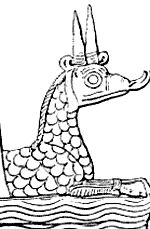
There is also the prominent Bohemian
Club member Ambrose Bierce who spent 3 years in England before he
came to San Francisco. Bierce wrote ’The Devil’s Dictionary’, a book
that shows us that at least some of the early members had a bit of
knowledge about pagan customs. In both cases we really need to know
more about these individuals before we can reach any conclusions.
What I know about them has been included in their bios, which can be
found in the membership list.
Following are excerpts of Bierce’s ’The Devil’s Dictionary’:
-
BAAL, n. An old deity formerly much
worshiped under various names. As Baal he was popular with the
Phoenicians; as Belus or Bel he had the honor to be served by
the priest Berosus, who wrote the famous account of the Deluge;
as Babel he had a tower partly erected to his glory on the Plain
of Shinar. From Babel comes our English word "babble." Under
whatever name worshiped, Baal is the Sun-god. As Beelzebub he is
the god of flies, which are begotten of the sun’s rays on the
stagnant water. In Physicia Baal is still worshiped as Bolus,
and as Belly he is adored and served with abundant sacrifice by
the priests of Guttledom.
-
BACCHUS, n. A convenient deity
invented by the ancients as an excuse for getting drunk.
-
CHRISTIAN, n. One who believes that
the New Testament is a divinely inspired book admirably suited
to the spiritual needs of his neighbor. One who follows the
teachings of Christ in so far as they are not inconsistent with
a life of sin.
-
DRUIDS, n. Priests and ministers of
an ancient Celtic religion which did not disdain to employ the
humble allurement of human sacrifice. Very little is now known
about the Druids and their faith. Pliny says their religion,
originating in Britain, spread eastward as far as Persia. Caesar
says those who desired to study its mysteries went to Britain.
Caesar himself went to Britain, but does not appear to have
obtained any high preferment in the Druidical Church, although
his talent for human sacrifice was considerable. Druids
performed their religious rites in groves, and knew nothing of
church mortgages and the season-ticket system of pew rents. They
were, in short, heathens and -- as they were once complacently
catalogued by a distinguished prelate of the Church of England
-- Dissenters.
-
FREEMASONS, n. An order with secret
rites, grotesque ceremonies and fantastic costumes, which,
originating in the reign of Charles II [ruled from 1649 to
1660], among working artisans of London, has been joined
successively by the dead of past centuries in unbroken
retrogression until now it embraces all the generations of man
on the hither side of Adam and is drumming up distinguished
recruits among the pre-Creational inhabitants of Chaos and
Formless Void. The order was founded at different times by
Charlemagne, Julius Caesar, Cyrus, Solomon,
Zoroaster, Confucius, Thothmes, and Buddha. Its emblems and symbols have
been found in the Catacombs of Paris and Rome, on the stones of
the Parthenon and the Chinese Great Wall, among the temples of Karnak and Palmyra and in the Egyptian Pyramids -- always by a
Freemason.

Always by a
Freemason, according to Bohemian Bierce.
-
MALTHUSIAN, adj. Pertaining to
Malthus and his doctrines. Malthus believed in artificially
limiting population, but found that it could not be done by
talking. One of the most practical exponents of the Malthusian
idea was Herod of Judea, though all the famous soldiers have
been of the same way of thinking.
-
MAMMON, n. The god of the world’s
leading religion. The chief temple is in the holy city of New
York.
-
MAN, n. An animal so lost in
rapturous contemplation of what he thinks he is as to overlook
what he indubitably ought to be. His chief occupation is
extermination of other animals and his own species, which,
however, multiplies with such insistent rapidity as to infest
the whole habitable earth and Canada.
-
SYLPH, n. An immaterial but visible
being that inhabited the air when the air was an element and
before it was fatally polluted with factory smoke, sewer gas and
similar products of civilization. Sylphs were allied to gnomes,
nymphs and salamanders, which dwelt, respectively, in earth,
water and fire, all now insalubrious. Sylphs, like fowls of the
air, were male and female, to no purpose, apparently, for if
they had progeny they must have nested in accessible places,
none of the chicks having ever been seen.
Well, what do you know? Respect for
Christians and an aversion to human sacrifice, malthusian genocide,
greed, and pollution of the environment. Not bad for a Bohemian
Grove participant, now is it? The Devil’s Dictionary is a satirical
work written over a period of about 25 years. Although you might get
that impression, it has very little to do with the occult, satanism,
or the devil, as some might fear at this moment. You won’t find many
other words in the book dealing with this type of subject.
Still,
the combination of Baal, Bacchus, the Druids, and
Freemasons
("secret rites, grotesque ceremonies and fantastic costumes") is
quite interesting in relation to the Bohemian Grove. Many people
claim that Baal is worshipped during the opening ceremony and the
ritual certainly shows some parallels with the rites associated with
this ancient god.
Bacchus has also been associated with
the Cremation of Care, just as the Druids (the Celtic music, for
instance). Peter Martin Philips, who has attended a Grove meeting
and talked to many of its members, wrote in his 1994 Ph.D
dissertation (1):
"The Cremation of Care Ceremony was
produced as a play in 1920, wherein a High Priest standing
before a huge pre-historic alter, is confronted by Dull Care
wrapped in the chains but not dead because Bacchus, the only
warrior Care fears, is truly dead... Care responds: ’Call
Bacchus from the grave... long as he is dead. I sneer at Great
Bohemia! Aha! Aha!’... Good Fellowship then takes the torch from
the priest at the alter and burns Care in his prison, thereby
purging the ’demon Care from the sacred Grove.’ This ceremony
has been rewritten on several occasions but the theme is still
the same."
[The date given, 1920, seems to be a
typo as the ceremony was first created in 1893. He also lists
two separate dates for the addition of the owl shrine: 1920 &
1929]
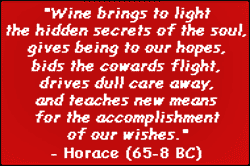
The Roman Bacchus is the same as the
more well known Greek Dionysus, the god of wine, sexual and ecstatic
freedom, fertility, and celebration. The purpose of their rites was
quite similar to the Bohemian Grove concept, i.e. the participants
were to leave behind any worries about their daily lives. Although I
have not been able to find the exact origin or meaning of Dull Care
(he’s
unhappy because of the death of his brother Don’t Care), the poem
above, written by a poet from the Roman Empire and the earliest
reference I could find, shows it has a strong connection to wine
also, just as Bacchus and Dionysus.
In any case, Dull Care is "a mocking spirit" that needs to be
banished from the Grove. This is an ancient tradition going back to
the Sumerians. The Sumerians used the word ’barra’ (begone) to
banish unwelcome spirits from the land. These traditions were spread
to Babylon, Greece, and Rome. After the Middle-Ages poets and play
writers occasionally picked up on it and incorporated it in some of
the works they wrote. The term was used quite frequently since at
least the late 17th century in Britain as the poems in
the left column show. The first reference since Horace that I was
able to find was the 1687 play ’Begone, Dull Care’ of [John] Playford:
Musical Companion, located in England. The emigrating poets and
writers took the term to the United States and many of them ended up
in San Francisco.
It could well be that the term Dull Care was already in use at the
time of the Francis Bacon group in the late 1500s and early 1600s,
which consisted of Sir William and Robert Cecil, John Dee, his
student Edward de Vere, Edmund Spenser, Bacon himself,
Elizabeth I,
James I, and several others. Why am I interested in them? These
people were (largely) responsible for the creation of Rosicrucianism,
Freemasonry, and Enochian Magic.
The de Vere family was involved in the
practice of Royal Witchcraft (2) and his family considered
themselves members of the
Archdruid-Dragon race. Bacchanalian
practices were well known within this group (more about that later).
The Bohemian Club’s primary motto, "Weaving Spiders, Come Not Here,"
also originated from them. It was taken from the second scene of Act
2 from ’A Midsummer Night’s Dream’, written by Shakespeare, who got
at least some of his inspiration from Edward de Vere (who’s lateral
descendant we coincidentally quoted throughout this article),
although a case can be made that de Vere wrote pretty much all of
the stuff that has been attributed to him.
(3)
The theme of Dull Care, however, was not
part of Shakespeare’s original MacBeth, but in the 1847 version of
Giuseppe Verdi a reference to Dull Care was made by Lady MacBeth
(which you can find in the column on the left). And to get back to
the Bacon group, they have been responsible for the British
colonization of the United States, whom Bacon thought was ’The New
Atlantis’ (4), while especially
the Cecils and many of their blood
relatives played a major role in creating the British and later
Anglo-American empire. As you’ll see a bit further in the article,
the elite Anglo-American families could well have had a hand in the
creation of the Cremation of Care ceremony.
Bohemian Bierce also described the Druids in his
dictionary, which have an interesting connection to groves. The word
’grove’ usually means ’a small wooded area’, but it
can also refer to a ’pagan way
grove’ or a ’pagan grove’, which is a learning center for different
pagan religions. Probably not by accident, the word ’grove’, as a
learning center, is most often used by pagans involved with the
Druidic traditions. Examples are the ’Celtic grove’ and the ’Druid
grove’. Robin Wood, a magic-enthusiast explains it a bit further
(5):
"Pagan Grove: An outer
circle, normally set up for teaching purposes, and led by a
Wiccan High Priestess and High Priest. This is where folks start
in many traditions (including mine) and learn what the Craft is
about, and whether it is the right Path for them. This is the
place you study for a year and a day before becoming an
Initiate."
"Initiates Circle: A Circle for Initiates only. These may
vary in form from non-initiates circles (often called Pagan
Groves) or not. In my own tradition, magic is practiced only in
the Initiates Circle, because a number of folk in our Grove
cannot yet ground and center reliably, and would get terrific
headaches from energy use."
Under normal circumstances one might not
contemplate the alternative meaning of the word ’grove’, especially
not when newspapers referred to a ’redwood grove’ ever since the day
the Bohemians bought their initial 160 acres in 1899. Still, the
decision to hire a piece of land in the redwood grove was made in
the early 1890s under the Bohemian Club presidency of Joseph D.
Redding. At the same time he created the original Cremation of Care
ceremony and acted as its High Priest. Redding had a completely
different background than the average Bohemian Club artist.
His father was a land agent for the
Southern Pacific Railroad Company, which was owned by the elite
Anglo-American Pilgrims Society families,
Harriman (chair of
Southern and Union Pacific was Edward Henry Harriman, who was
financed by Jacob Schiff) & Harkness (major shareholders of
Rockefeller’s Standard Oil; intermarried with the Stillmans, who
also intermarried with the Rockefellers; partners of J.P. Morgan;
co-founders of the Commonwealth Fund and the Pilgrim Trust).
Redding
went to Harvard Law School and became a wealthy lawyer for Southern
Pacific. Southern Pacific is a great example of the reported schism
that happened within the Bohemian Club between the original middle
class artists and the wealthy businessmen. In May 1898 Southern
Pacific created Sunset Magazine, which dealt with the outdoors,
artistic writings, and things about everyday life. In 1911 Charles
K. Field, a member of the Bohemian Club, became its editor.
Bohemian Club writers like Ina Coolbrith,
Jack London, Bret Harte, and John Muir contributed to the magazine,
but as time progressed all these writers became increasingly
critical of the business ways of the robber barons. Because of this
development Southern Pacific had to do away with the magazine in
1914. And by this time the Cremation of Care founder was living in
New York, surrounded by members of the Pilgrims Society.
The term ’Bohemian’, by the way, has very little to do with the
East-European region of Bohemia. The original Bohemians were a group
of penniless rebellious young artists living in 19th century France.
Among them were Victor Hugo (wrote ’Hunchback of the Notre Dame’ and
is today an inspiration for the elite European Institute), Arthur
Rimbaud, Alfred De Musset, and Paul Verlaine. Those who referred to
these people as ’Bohemians’ meant that they thought of them as
Gypsies (low life). The first accusation we know of was made in 1834
by Felix Pyat in a Parisian publication called ’Nouveau Tableau de
Paris au XIX Siecle’. It read:
"alien and bizarre... outside the
law, beyond the reaches of society... they are the Bohemians of
today."
The Frenchman Henry Murger was
the first to popularize the term in his 1849 novel ’Scenes de la Boheme’,
which was turned into a play 2 years later. In this book the main
character, together with a few newly found friends, is involved in
creating a small unofficial Bohemian club at a local Parisian
tavern. Murger’s description of a Bohemian is someone who purely
lives of the art he creates. Bohemia, according to him, was located
in Paris. So, I guess it’s pretty obvious to see where the San
Francisco artists got their inspiration from when they established
the Bohemian Club in 1872. And they might have been totally
different persons then those who inspired the creation of the
Cremation of Care.
The Owl
The Bohemians adopted the owl as their mascot right from the
beginning, but it is doubtful that they attached any serious
mystical values to it at that moment. Today, when the average person
sees pictures or videos of the Cremation of Care ritual they will
usually get away with an entirely different impression. Who would
ever have imagined that the president of the United States, together
with a large chunk of America’s elite, attends a yearly gathering
where an ancient Babylonian (mock) human sacrifice is carried out in
front of huge stone owl?
The original Bohemians were quite eccentric
(and the absolute opposite of today’s Grovers), but this is just too
bizarre. So whatever the owl meant for the early Bohemian Clubbers,
it is quite reasonable to philosophize a bit about what the owl is
supposed to represent these days. After all, the Cremation of Care
was devised by a not-so-average Bohemian and the giant stone owl was
only put into place in the 1920s when the Grove already was an elite
gathering for at least 10 to 15 years. In fact, the nationwide
coverage of the Cremation of Care ceremony around the turn of the
century seemed to have drawn in lots of important people.
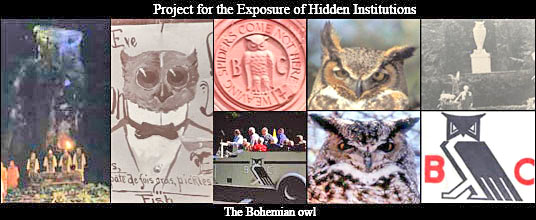
Traditionally, at least in conspiracy land, the
owl in the Grove is
associated with Moloch, although more and more people start to ask
questions about that assumption. The reason for that is if you
compare the above images with the descriptions and depictions of
Moloch (below) you’ll find that there’s quite a difference. I have
never seen a non-Bohemian Grove related article in which Moloch is
associated with an owl.

But even though I don’t interpret the Bohemian owl as
Moloch/Baal,
the Cremation of Care is very similar to the ancient rites
associated with this sun god. In the left column you can find a
detailed transcript of the rites of Melqart, the Tyrian version of
Baal and Molech, and how these spread to the Druids. More
information about similar rites can be found further down in this
article.
Anyone who does a bit of research in European and Middle-Eastern
mythology will see that the owl is always associated with a female
deity. In all the civilizations between Sumer and Rome (and even
the
Celts) you have a few recurring gods with often the same symbols
associated with them. I tend to throw the important gods and
goddesses together and define only two simple classes, the first one
being the male sun gods, followed by a group of female mother-moon
goddesses. The simple reason is that mythology is a mess.
Stories
are completely incoherent and often you can make anything of it that
you want. Each new civilization copied the gods from the previous
one and it is obvious that many mistakes (or deliberate changes)
were made during this process. This is the reason that modern
mythology, to a large extent, is nothing more than making "best
guesses" in defining which deity is associated with which earlier
deity. That also seems to go for the initiates of secret societies.
The sun gods, who normally have one or more sons, are usually
depicted as (or with) bulls, goats, fire, and sunlight. Examples are:
-
the Egyptian Amun-Ra
-
the Carthaginian Baal-Hammon
-
the Babylonian Marduk
-
the Canaanite Baal and Molech
-
the Tyrian El and Melqart
-
the Akkadian Adad
-
the Greek Zeus
Then there are mother and
moon goddesses. The first one is usually associated with the dove or
a lion (and is the partner and mother of different sun gods).
These are generally identified as the exact same
goddesses. Goddesses associated with the moon, who are always
closely related to the mother goddesses, are often depicted as an
owl.
Going back further is hard, but we have a few
leads.

There is a well known Sumerian clay tablet with a female deity
depicted on it. She is standing on two lions and is flanked by
two
owls [1]. Generally, this tablet is said to depict Lilith, a
demoness, but the connections are weak and many scholars doubt this
is the correct interpretation. Lilith has vaguely been associated
with the "screech-owl", but that doesn’t automatically mean the
tablet depicts this semi-goddess. In my opinion the goddess Inanna
would be a much better choice, because:
1) It is generally accepted
that Innana became Ishtar, Semiramis, Cybele, and Astarte, which are
all mother goddesses with the dove and lion as main attributes. This
explains the ’mystery’ of the bird feet, the wings, and the two
lions she is standing on
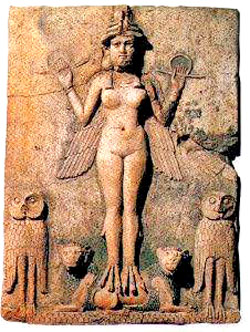
2) Deities with similar objects in their
hands as the ones depicted on the Sumerian clay tablet have been
associated with Ishtar, the Akkadian version of the Sumerian Inanna
Even so, the question still remains who the owls on the clay tablet
are supposed to represent, because the later civilizations seem to
have reserved the owl for a separate deity. Since Inanna’s parents
were the moon god Nanna and the moon goddess Ningal, I guess I agree
with those people that claim Inanna was also associated with
the
owl. But in the end we really can’t tell what the owl in the grove
is supposed to represent.
Nicholas de Vere, a lateral inheritor of
the Dragon title from the earlier mentioned extinct Earl of Oxford
branch and a former head of the British Dragon Court
(6), gives us
another possibility of what the owl might mean to certain elite
groups:
"The Dragons - and in the King James Version of the Holy Bible - the
Daughters of the Owl (Lilith), are therefore - according to Isaiah -
the true children of God;
"A Chosen Generation, a Royal Priesthood,
an Holy Nation, a Peculiar People..."
"Astaroth is Ishtar, who was a draconian relation of
Lilith
the
dragon queen, the ancestral grandmother of the Tuadha de Danaan..."
(7)
"The Garter was the
’witches belt’, the Devil’s badge and a dynastic
emblem of the fairy race that descended from Lilith and Cain, who
were the enemies of the Church and Mankind, according to the church,
if not according to the fairies themselves."
(8)
Maybe you noticed that I never mentioned
the Egyptian mother goddess Isis. The reason for that is the Egyptian pantheon often uses
completely different attributes for the same deities than other
parts of the ancient Middle-East. Although the owl could well
represent Isis, we don’t need to worry about her, because she is
certainly present at the Grove. Peter Martin Phillips again:
"Bohemians even own a 2,500 year old mummy donated to the Club by an
Egyptologist, Jeremiah Lynch in 1914. The mummy, known as Lady Isis,
rests in a glass case near the entrance to the Bohemian theater."
The goddess Diana is also present at the
Grove. A picture of her statue, which is located near the ’Diana
Circle’, has been among a few dozen photos ’Kyle’ has managed to
snap in 2004 and 2005 as an employee at the Bohemian Grove.
(9)
I also didn’t mention the Celtic Arianrhod and the wife of her son,
Bloudeuedd. Both had the owl as a main attribute. Arianrhod is a
mother goddess and moon goddess at the same time. She is linked to
Aphrodite and Isis, but also to Astarte (dove and lion; same as
Ishtar and Inanna) and Diana.
I told you so, mythology is a mess.
The Mitre of the Bohemian Grove priest

Looking at the Bohemian Grove high priests [7-8-9] I noticed that
they bear an uncanny similarity with a person known in the
Netherlands as "Sinterklaas" [5], less commonly known as
St.
Nicholas of Myra, a bishop that lived in the 3rd and 4th century AD
and was a member of the Council of Nicaea in 325. The Americans
changed his appearance to the more fluffy looking Santa Claus early
in the 20th century. Not that I think the Bohemian Grove priest is
Santa Claus, it’s just that the Catholic church has received all
their inspiration from the earlier pagan religions.
The mitre, that
also seems to reside on the heads of the Bohemian Grove priests, is
one of the best examples of this. It represents the open mouth of
the ancient half-man half-fish god that brought humankind
civilization. It was worshipped under different names: Enki,
Ea,
Dagon, and Oannes. Apsu (supposedly the origin of the Dragon race)
and Atargis are other half-man half-fish gods which are even older
than the sun gods. In the pictures above you can clearly see how the
process evolved.
So ironically, the Pope, St. Nicholas, the Bohemian Grove high
priests, and even Santa Claus all have the same origin:
The
Sumerian-Babylonian high priests. This is also where their rods and
capes have originated from (10).

What are those? Fishies? Brings back memories of that horror movie
’Dagon’, originally written by Lovecraft.
The problem with the Dionysiacs and Bacchanalians
The worship of Dionysus is generally considered to have started in
Phrygia in Asia Minor between 1200 and 1000 B.C. after which it
spread to Greece, Egypt, and as far as India. The cult became known
for its extensive use of trance-inducing music, sex orgies, wine
consumption, and the large amount of violent sacrifices, which, at
least in the earlier stages, included humans. As a mystery cult it
had public and secret rites.
One of the rites included the Maenads,
a group of insane woman involved in bizarre blood rituals. This
included the ripping apart of human beings and eating their flesh.
During this time they were possessed by Bacchus who provided them
with superhuman strength (11).
Nicholas de Vere, in his book ’The
Origin of The Dragon Lords of the Rings’, adds:
"The Dionysic Rites were cannibalistic and vampiric and echo the era
of the cannibalism and vampirism of the (Titanic) era of the sons of
the Nephilim."
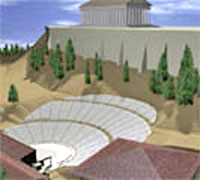
Theater of Dionysus
After the cult ended up in Athens in the 5th
century B.C. they build a theater in honor of Dionysus on the southside of the Acropolis. It was later remodeled in stone. In the
Dionysic theaters of Greece and Rome many plays were held, usually
centered around their respective mythologies. The beginning of every
festival was always reserved for sacrifices. Most scholars are of
the opinion that in those days the sacrifices didn’t include humans
anymore, at least not publicly, but the amount of animals killed was
quite substantial.
For instance, in 333 B.C. there was a single event in which 240
bulls were sacrificed to Dionysus (12). That must have been quite a
blood bath. Much later, in 186 B.C., after accusations of human
sacrifice, violent sex orgies, and the plotting of assassinations
and other political conspiracies, the Roman Empire banned the
’Bacchanalias’ and executed a few thousand of its members. It is
likely that some of these accusations were exaggerated, although
most of these claims were fairly well documented in earlier times.
According to
Manly P. Hall (13), the cult was composed of a
secretive inner core of highly skilled architects who based their
public buildings on sacred geometry and astrology (they often
mirrored their structures with a particular constellation). Among
the initiates were those that built the Tyrian Temple of Melqart,
who in turn were employed by King Solomon to build the first Jewish
temple at Mount Moriah in 969 B.C. Solomon has always been
considered an important magician to the members of various secret
societies and God is said to have given him control over the Jinn
(elemental beings that can be conjured up). These helped him to
build his temple and cities alongside his human employees.
In 206 B.C. another very prominent deity was imported into Rome from
Phrygia: The mother-goddess Cybele, which used to be worshipped
right next to Dionysus. Her orgiastic rites were very similar and
the high priests were castrated, told to live as women, performed
blood sacrifices (animal only as far as I have seen), bathed in
blood, and cut themselves open during certain ceremonies
(14).
Although the history of the
secret societies is extremely complex,
it isn’t very hard to link the Dionysic architects and Solomon’s
temple to the Rosicrucian Knights Templar and their Rosslyn Chapel.
The Templars had been digging underneath Mount Moriah in the early
12th century. After they fled to Scotland in 1307, their descendents
built a new version of Solomon’s Temple in the 15th century. Not
long after the Templars arrived, the
Order of the Garter and
the
Dragon Court were (re)established in Britain, hints of Rosicrucian
initiations started to surface, and Enochian Magic was born,
followed by the birth of Scottish Rite Freemasonry (for the more
common man). Even the Dragon Court, quoting the Catholic dictionary,
accepts that the Templars fled to Scotland and gave rise to
Freemasonry there (15).
The worship of Bacchus also went along
within some of the secret societies. One of the most notorious
pleasure-seeking Bacchanalians of British history was Sir Francis Dashwood of the
Hellfire Club
(16), who, in the mid-1700s, had
reserved a central role for Bacchus/Dionysus in his own rituals. The
"do what you will" quote, inscribed above the main entrance of the
Medmenham Abbey (below images) where many of his rites were performed, served as an
inspiration for
Aleister Crowley.
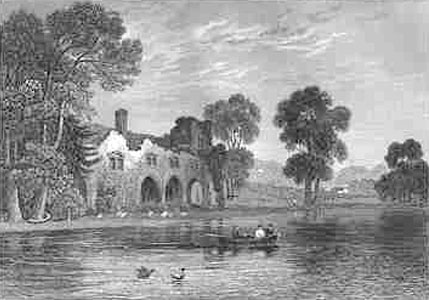 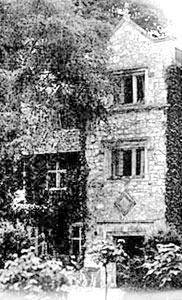
Dashwood visited many European
royal courts in his younger years, ultimately becoming Chancellor of
the Exchequer and a member of the Privy Council (1761). Franklin, an
occasional visitor of the Hellfire Club, eventually became a
Founding Father of the New Atlantis, better known as the United
States of America.
In Britain, it seems that Druid and Templar practices merged,
followed in a later stage by Jewish bankers (probably kabbalists/hermeticists)
who, just like the Rosicrucian Bacon and other hermeticists, were
also inspired by Solomon and his temple. This last group, headed by
the
Rothschild family, decided in the 19th century that it was time
for the Jewish people to return to Palestine and allied themselves
with the British Empire (in Quigley’s Round Table, headed by
Robert
Cecil, the 3rd Marquess of Salisbury)
(17).
This merging of the
different elements, which is also what probably happened at the
Bohemian Grove, is supported by Nicholas de Vere in ’The Origin of
The Dragon Lords of the Rings’:
"The rituals of witchcraft were varied and contained syntheses of
Catharist and Templar Dualism, Druidism and Bacchanalian practices."
Benjamin Disraeli, the first Jewish Prime Minister of England and a
close friend to both the Rothschilds and the Cecils, used to refer
to Queen Victoria as "the Faery", which is usually thought of as
nothing significant. However, looking at Disraeli, a
Knight of the
Garter, a friend to the founders of
the Round Table, and in the know
of the influence of secret societies, it is probably a reference to
Edmund Spencer’s story "The Faery Queen" (as he called
Queen
Elizabeth I) which also featured a "Red Cross Knight" (Rosicrucian).
Spenser was part of the Francis Bacon group and a close friend to
John Dee, who is the founder of
Enochian Magic and credited with
writing ’The Rosicrucian Secrets’. Spenser dedicated several works
to Dee’s student, Edward de Vere, who he is supposed to have visited
on a regular basis (de Vere married Lady Anne Cecil and early on
lived in the household of Sir William Cecil).
Nicholas de Vere, in ’From Transylvania to Tunbridge Wells’, adds:
"Castle Matres or Matrix as it is now known was said to have been
named after the Matres or triple goddess. The castle rests on the
banks of the river Deal in County Limerick and the library which was
housed there is said to have contained singular works on Magic and
Alchemy, works that Dee didn’t want, under any circumstances,
falling into the Queen’s hands because, as
Laurence Gardner has
pointed out, Dr. John Dee, Edward de Vere, Francis Bacon, Edmund
Spenser and William Shakespeare et al were well aware that
Elizabeth’s house were badly bred usurpers and despite the descent
from Margaret of Anjou, the blood wasn’t pure."
"The dragon or fairy gene was very rare and true archdruidic, royal
dragon families were rarer still... Ubaid Sumerian-Scythian in
origin. These Dragon Kings and Fairy Queens weren’t extensive in
number, didn’t breed outside their caste and weren’t nationalists or
racists. How the Germans ever thought they were all descended from
them is beyond understanding."
And in ’The Origin of
The Dragon Lords of the Rings’:
"Given that the Fairies, according to
Murray, were still around in Shakespeares time (Edward de Vere? -sic), it seems to me that at
least one individual who is said to have been a member of the
literary syndicate that produced A Midsummer Night’s Dream ["Weaving
spiders, come not here"], diminuted the fairies, his own race, it
could be argued, in order to alleviate the persecution that was
raging against them..."
It’s hard to tell how many of these practices are still going on
today. If we stick to the non-criminal aspects, all I have come
across are some stories about Tony Blair, who gets his advice from
’the light’ (18), and his eccentric New Age wife, who likes to drag
her husband into Aztec rebirth rituals
(19) and other standard
paranormal practices (20). Then there are some reports about
astrologers helping members of the royal house, which aren’t really
worth repeating here (gossips). Keep in mind that these are/were the
most prominent persons in Britain of the past 10 years.
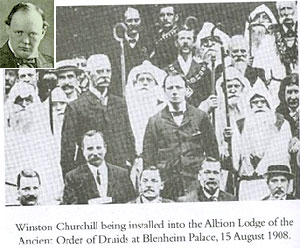
The
old
dynastic blue blood families seldom reach the news in the first
place. Another interesting fact is that politicians and Anglican
church officials are regularly invited into Druid groves. When this
is reported in the news the usual response is that "it’s perfectly
Christian", although a detailed explanation is seldom, if ever
given. I think it’s a bit strange that Christian leaders do not
actively
attempt to take away people’s concerns when they join certain
organizations (formerly?) associated with pagan practices.
Nicholas
de Vere, in ’The Origin of
The Dragon Lords of the Rings’, wrote:
"In this is borne out, by the Druids ready acceptance of Celtic
Christianity, the fact that Jesus’ original, undoctored Gnostic
teachings were founded on Essene Magian Philosophy amalgamated with
the mystical doctrines of Mithras and Dionysus. Alchemy, Cabala and Hermetics were the centre of
Christ’s Anschauung. All the foregoing
are components of that Eurasian "religion" we know as Druidism
which, for the Indians is Hinduism and for the Persians is their
Zoroastrianism which for the West eventually became our Celtic
Christianity."
Make of it what you will. Among the more prominent officials that
have been invited into Druid groves are:
-
Winston Churchill (Prime
Minister)
-
David Lloyd George (Prime Minister)
-
Queen Elizabeth II
-
George Noakes (Archbishop of Wales)
-
Rowan Williams (Archbishop of
Canterbury)
-
Daniel Mullins (Roman Catholic bishop of Menevia)
(21 & 22)
Undoubtedly this is only the tip of iceberg, but
individuals aren’t exactly forthcoming about these aspects of their
lives. This is not at all to say that these people are wicked. After
all, it is part of their history. It’s just that some of the
publicly known groves have a lot of similarities with the Masonic
groups of which a certain degree of secrecy and elitism is a basic
ingredient.
In both cases the participants come to their groves and
lodges to "discuss literature, poetry, music and art" and maybe to
do a bit of tree-hugging or to perform a few dusty old rituals. In
case of the Bohemian Grove a lot of these people come there to
network, although they’re all pretending not do to that ("makes it
easier to pick up the phone"). But all these groves, just as all the
publicly known Masonic degrees, are only supposed to be outer
circles anyway, part of the ’association of helpers’ so to speak, so
who really cares what the participants think.

Conclusion
What have we learned about the Bohemian Grove in this article? Well,
besides that the Anglo-American elite probably inspired the
Cremation of Care, actually surprisingly little. We’ve gone all over
the Middle-East, Mainland Europe, England, and the United States,
but still some of the basic questions have not been answered (to
most people’s satisfaction). Who or what is the owl supposed to
represent and do the Bohemians themselves have any idea?
To some it
might refer to ancient Greece (Athena), which has always served as a
great inspiration to the western world. Others might be of the
opinion that it is a reference to Ishtar or Inanna. Still others
might be of the opinion that it symbolizes Lilith and her Dragon
lineage. And still others undoubtedly think the owl is nothing more
then the Bohemian Club symbol. Then again, is the owl surrounding
the capitol building just a coincidence?
Other unanswered questions are:
-
Who or what inspired Joseph Redding
to put together the Cremation of Care?
-
Do some of the observers of
the Cremation of Care indeed go into a good old Bacchanalian
ecstatic trance state during the beginning of the ritual, like Alex
Jones and Jon Ronson have described
(21)?
-
What is the opinion of
the Bohemian Grovers of the flyer, obtained by
Alex Jones and Jon Ronson,
that clearly depicts a baby having been sacrificed in the Cremation
of Care fire?
-
Or what is the opinion in general of the Bohemians as
they watch a pretty macabre openings ritual?
To be honest, I am not that interested in the
Bohemian Grove all by
itself and this article has largely been just an excuse to dabble a
bit in the mystical aspects of the globalist movement and to look
for the origins of some of its perversions (which we will focus on
in the future). Western mysticism is elitist, seems to have great
influence over the more mainstream religions, is hopelessly
intertwined with politics, banking, law, and intelligence, and if
you look below the thin layer of paint, you’ll see that most of the
upper level people don’t seem to have any degree of spiritual
enlightenment whatsoever.
My guess is that the Grove’s Cremation of Care is a visible aspect
of a hidden hermeticist religion with very unconventional ideas.
Poets and other artists often communicated hidden messages and
double meanings within the works they wrote, especially when they
were connected to high society. Even regular artists (take Iron
Maiden) (24) are fond of doing that, but this certainly has always
been a specific trait of Rosicrucianism, Freemasonry,
Druidism, or
any other mystery religion. Shakespeare, or the 17th Earl of Oxford
if you will, is often cited as an example and Joseph D. Redding
might well turn out to be another one. But in the end your guess is
as good as mine.
Quick note on magic
|

Criss Angel aka "Mindfreak"
in one of his recent TV shows |
Masaaki Hatsumi, the only grand master of ninjutsu still alive,
wrote (25):
"People
who perform genjutsu are called magicians, illusionists, and
rainmakers. They are influenced by Mikkyo (secret teachings of
Dainichi Nyorai) and dokyo or Taoism. In comparison with genjutsu,
yojutsu is eerie and performs its tricks by borrowing the
supernatural powers of the various spirits...
We must realize that
these tricks, used to deceive people, were taught for that purpose;
thus the performers gain a wicked heart by training in them... such
tricks or miracles as making the wife of a samurai who had been dead
for five years, appear in front of the widower’s eyes... [or
showing] a man in hell being gruesomely tortured... [but] the ninja
utilize yojutsu and genjutsu in inton jutsu (hiding techniques) and
in intrigue."
From his writings it is clear that Hatsumi is no fan of magic and he
once wrote it "leads to ruin," or something like that. On the
other hand, even with all his personal experience, I get the
impression that Hatsumi only spoke from a historical Japanese point
of view, which was seemingly filled with mischievous
magicians/illusionists who were only after personal gain (and now
that I am thinking of it, how about our own past?). I think that a
recent show like Mindfreak (a US illusionist) is great, because it
gets people thinking and studying about things we all should be
aware of.
|

Crowley’s Lam.
Notice the Ankh and eagle wings (1919) |
If we exclude the theory that hundreds of witnesses have
been bought for each individual episode (and no one has reported
that yet), the show does provide serious evidence to everyone that
the laws of reality can be bend to the extreme, whether that’s due
to a ’what you see is what you get’ effect or due to a form of mind
control. Think of the military potentials alone, the secrecy that
would surround it, and how this would be maintained (by messing with
one’s mind).
|

Chart of the
occult and political relations of the Cecil bloodline |
Hatsumi’s note, "borrowing the supernatural powers of the various
spirits" (as opposed to developing a power, if possible, yourself),
is also interesting because Western
ceremonial magic is largely based on that: the interaction with
elemental spirits. Solomon, who’s every magician’s inspiration (the
two Masonic pillars refer to the two pillars of his temple), is
reported to have been a master in it.
John Dee, a teacher of de Vere
and associate of the Cecils, did this stuff together with Edward
Kelley through their Enochian magic. In that case they definitely
contacted the wrong beings who made them do things they weren’t
exactly pleased with (26).
Arthur Balfour, a relative of the Cecils,
was holding seances at his house contacting god-knows-what
(27).
Crowley, supposedly once a
protégé of the Cecils (28), was inspired
by one of these beings and contacted numerous others. One of these
other beings,
Lam, looked an awful lot like a type of
grey alien.
There’s much more to this story, especially if you look at some of
the reports that have been made in recent years, but that’s a whole
other article.

More Mindfreak. In one of his episodes he turns water into beer. Now
what does that remind you of?
It doesn’t have to be a liquid though.
It is seemingly possible to change it in anything someone can
imagine.
Endnotes
[1] 1994, Peter Martin Philips, ’A
Relative Advantage: Sociology of the San Francisco Bohemian
Club’ (Ph.D. dissertation)
[2] 2005, Project for the Exposure of Hidden Institutions,
A
chart that depicts some of political, economic, and occult
connections of the Cecil bloodline.
[3] April 6, 2000, ’Mr. Schelle’, ’Shakespeare or De Vere: That
is the Authorship Question’
[4] Early 17th century, Francis Bacon, ’The New Atlantis’
This unfinished roman was released after his death in 1626 and
described how a group of sea explorers ended up on a previously
unknown island which had superior technology and knowledge about
all parts of the world. Solomon was considered the greatest king
that had ever lived and the inhabitants themselves showed many
similarities with the later Rosicrucian movement. According to
the people of this island, Atlantis, one of their trading
partners, was located in the northern half of the Americas and
was destroyed in a catastrophe a long time ago.
[5] Robin Wood, Magic for Pagans & Wiccans FAQ
[6] 2005, Project for the Exposure of Hidden Institutions,
Dragon article
[7] 2000, Nicholas de Vere, ’The Origin of
The Dragon Lords of the Rings’
[8] 2002, Nicholas de Vere, ’From Transylvania to Tunbridge Wells’ (today known as
’The Dragon Legacy’)
[9] Ted Gunderson has uploaded the pictures to his site. A few
have also appeared on the website of Coast to Coast AM.
[10] 1858, Alexander Hislop, ’The Two Babylons’
[11] A combination of Britannica Concise Encyclopedia &
Wikipedia gives most of the facts about the Maenads
[12] 1999, Encyclopedia of the World Mythology (Dutch edition)
Although it’s quite a thick book it turned out to be useless in
most cases, as a lot of mainstream books are that deal with this
kind of subject. They focus too much on the myths and too little
on the actual practices associated with these deities.
[13] 1928, Manly P. Hall, ’The Secret Teachings of All Ages’
[14] May 21, 2002, BBC, ’Dig reveals Roman transvestite’
[15] 2005, Project for the Exposure of Hidden Institutions,
Dragon article
(Includes the correspondence with the Royal House
of Stewart)
[16] September 9, 2002, The Age, ’Libertine turned home into an
orgy’
[17] 1981, Carroll Quigley, ’The Anglo-American Establishment’
[18] March 07, 2004, The Sunday Times, ’Conman Foster kicks PM
in pants’
[19] March 2004, Book review of the book ’Pretty Straight Guys’
[20] September 20, 2005, London Independent, ’Witchcraft and
nail clippings: the weird world of Cherie Blair?’
[21] July 19, 2002, The Times, ’Why The Archbishop Is Embracing
Pagan’
[22] August 6, 2002, The Scotsman, ’Archbishop hits back in row
over druid honour’
[23] September 6, 2005, Coast to Coast AM, Jon Ronson talks
about the fanaticism during the Cremation of Care. Alex Jones
and Ronson also talk about their tapes that got erased.
[24]
You already guessed, one of my favorite bands. Maiden is a
great example how uneducated everyone is about even the basics
of the mystery religions. This band has countless of millions of
fans all over the world, but at least in mid-2005 (last time I
did an inet check) none of their fans had picked up on all the
pyramids and eyes they put in their 1984 Powerslave tour. Over
the years this influence has become more and more obvious,
especially with their (amazing) album Brave New World in 2000
and Dance of Death in 2003. Earlier, Bruce Dickinson wrote songs
like The Chemical Wedding, Book of Thel, Gates of Urizen, The
Alchemist, The Magician, and Omega, while Iron Maiden (without
Bruce) wrote the song The Sign of The Cross (The Name of the
Rose). I don’t mind at all that they do this, but it’s quite
amazing that nobody has pointed out the obvious yet. Maybe the
2003 song Montsegur is going to change that.
[25] 1988, Dr. Masaaki Hatsumi, ’Essence of Ninjutsu’
(additional info below)
[26] 2002, Channel 4, ’Masters of Darkness - John Dee 1527-1608’
[27] Wikipedia, ’Society for Psychical Research’
[28] Red Flame, A Thelemic Research Group, Lord Tredegar bio
Additional References
[A] 2005, Graham Hancock &
Robert Bauval, ’Talisman - Sacred Cities, Secret Faith’
[B]
De Vere interview by Tracy R. Twyman
[C] 2001, Dr. Masaaki Hatsumi & Benjamin Cole,
’Words of
Consequence - Understand? Good. Play!’ (Hatsumi on mind control
- below insert)
|
’Words of
Consequence - Understand? Good. Play!’
Dr.
Masaaki Hatsumi & Benjamin Cole
2001
"Call it
Mind Control, call it psychology, call it human nature -
there is nothing particularly scientific about this
’thing’ that makes us human... You are merely learning
to utilize this human nature through shinnenjutsu."
"(Soke calls to Shiraishi-sensei, who stands up to take
position as uke for the next technique. As soke
approaches, he declares) "Don’t stand up! Don’t stand
up! Don’t stand up!" (Soke overwhelms Shiraishi-sensei,
who is now cowering and is having difficulty standing up
straight. Soke turns to the class and states
emphatically) "This is that something." (Seconds later,
Soke calls to Shiraishi-sensei to punch. Just as the
punch lunges forward, Soke puts up his hand, declaring
"Stop!" Shiraishi-sensei is caught in mid-technique,
unable to finish his punch. Soke turns to the class.)
"You must be able to control your opponents like this."

When I
give the fifth dan test, I invoke sakkijutsu wherein I
project outward my intention to
Masaaki Hatsumi performing the standard 5th dan test.
kill; and the candidate, sensing that intent, escapes to
safety. Everyone who has passed the fifth dan to date
has passed the test in this fashion. In the case of
demonstrations, however, like the one we did for
television the other day, I use this
type of mind control to literally push the candidate out
of the way of the sword. |
|



















